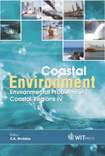The Influence Of Tides And Wind Speed On Fine-sediment Transport In A Semi-enclosed Natural Harbour (Pagham Harbour, UK)
Price
Free (open access)
Transaction
Volume
58
Pages
Published
2002
Size
455 kb
Paper DOI
10.2495/CENV020181
Copyright
WIT Press
Author(s)
H M Burgess, S B Mitchell & D J Pope
Abstract
The influence of tides and wind speed on fine- sediment transport in a semi-enclosed natural harbour (Pagham Harbour, UK) H M Burgess, S B Mitchell & D J Pope Hydraulic Engineering Research Unit, School of the Environment, University of Brighton, UK Abstract Preliminary analysis of results from a study of tine sediment transport in a macrotidal harbour (Pagham Harbour, West Sussex, U.K.), has revealed patterns of fine sediment transport which may be related to the tidal range and the wind speed. This paper will present preliminary analysis of regular and frequent monitoring of turbidity, salinity, water level, wind speed and wind direction over a continuous 70 days period. Analysis of sediment transport over individual tidal cycles has also been carried out, in order to ascertain a possible mechanism for the flux of fine sediment to and from the intertidal mud areas. Shorter, faster flood-tide currents lead to concentrations of suspended sediment that are normally highest during the first 90 minutes of the flood tide. These concentrations decrease rapidly due to settling, during the relatively low velocities at, and immediately following, high slack water. Peak flood-tide suspended sediment concentrations appear to be correlated more with tidal range, than with wind speed, suggesting that there is a greater sediment mobility during spring tides. Introduction The management of semi-enclosed natural harbours around the UK coastline relies on a quantitative understanding of the processes of fine sediment transport within these systems. Several such systems, generally characterised by a narrow harbour entrance and relatively low fresh water input, exist along the heavily
Keywords





